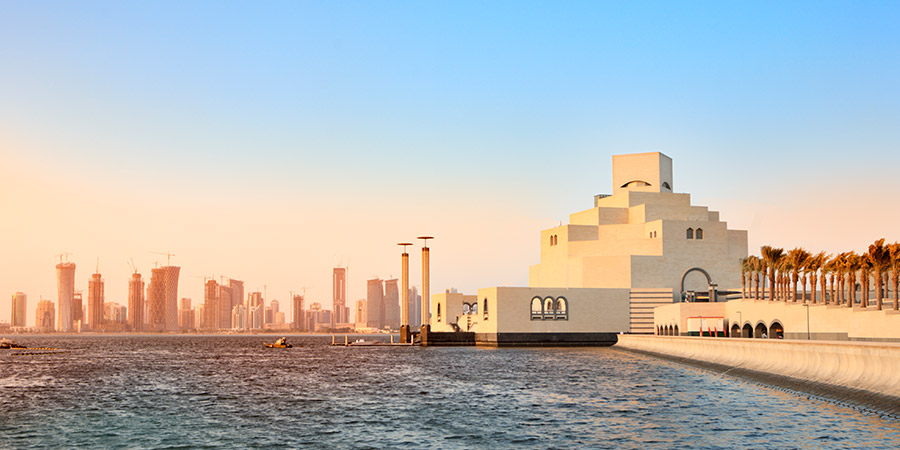
Poised at the end of Doha Bay, the Museum of Islamic Art rises from the waters of the Arabian Gulf. The climate and corrosive salt environment of the Persian Gulf created a number of challenges for this striking new building. Developed on reclaimed land, the museum’s foundation rests below the water table, subjecting foundations to highly aggressive chloride and sulfate conditions that can quickly deteriorate the concrete and significantly reduce the life of the structure.
The project team needed a waterproofing membrane that was not only well suited for the corrosive salt environment of the Persian Gulf, but also for Qatar’s severe heat – often in excess of 40°C (104°F). They applied PREPRUFE® 300R waterproofing membrane below the slab to prevent water migration around the substructure and BITUTHENE® 8000 HC waterproofing membrane to protect the substructure walls from the harsh ground environment. This continuous waterproofing system fully bonded to the structural concrete surrounding the substructure, creating a positive and permanent barrier against the corrosive environment.
The museum was not the only structure to need protection against harsh elements.
The Alaskan Way Viaduct transportation project involved carving a two-mile-long highway tunnel under downtown Seattle. The 60-foot-deep jobsite was virtually floating in water. Water fountains shooting four feet or higher routinely burst through the mud slab. Secant piles offered only token water resistance. And still it rained and rained.
The transportation infrastructure faced a daunting series of issues, including:
- Meeting specifications that called for a clay membrane waterproofing solution
- Working dozens of feet below the water table during one of the rainiest periods on record
- Complying with harsh warranty requirements for near-zero water leakage
- Maintaining a hyper-aggressive project schedule
Bill Parks, project manager for waterproofer F.D. Thomas, knew if they could clear one crucial hurdle—changing the original waterproofing specs of the transportation infrastructure—he and his team could meet the demanding expectations. “We insisted on using the PREPRUFE® SCS system,” Parks recalls. “If we had used the other system, it would have been a disaster.”
Learn more about PREPRUFE® Plus pre-applied waterproofing
The PREPRUFE® SCS pre-applied system is engineered for shotcrete linings. The easy-to-apply membrane and injected grout created a uniform and continuous waterproofing system, sealing off the structure with a resilient cover and ending lateral water migration. While up to two years of work remains on tunnel boring and finishing, the south portal transportation infrastructure results are outstanding. F.D. Thomas has installed the PREPRUFE® SCS system to keep the tunnel dry.
The Museum of European and Mediterranean Civilizations was also faced with protecting its new structure against challenging conditions. Built on the shores of the Mediterranean Sea, the new 65€ million Museum of European and Mediterranean Civilizations sits on reclaimed land at the entrance to Marseille’s historic harbor.
The museum’s coastal proximity meant a comprehensive waterproofing system was needed to protect the slab from water ingress, provide protection from salt and sulfates in the ground, and preserve the lifespan of the structure. Faced with salt water exposure, high water tables, and fluctuating temperatures, of PREPRUFE® waterproofing membrane proved to be the ideal solution to provide watertight protection from below the ground up.
PREPRUFE® is an advanced membrane system that protects substructures from the harmful effects of water, vapor and gas. The membrane’s synthetic adhesive layers aggressively adhere to concrete, forming a unique intimate seal that prevents any water migration between the waterproofing and the structure, substantially reducing the risk of leaks. In addition, the BITUTHENE® LM asphalt-modified liquid membrane was installed to provide a continuous waterproofing barrier system between the concrete slab and diaphragm walls – meeting the museum construction project’s comprehensive waterproofing needs.
Related articles
May 28, 2018
Pre-applied Waterproofing: Understanding concrete bonding methods
Pre-applied waterproofing is used below basement slabs and behind walls on job sites where there is limited space for excavation and heavy equipment. Instead of pouring the foundation and then applyin...
READ MOREAugust 24, 2018
Understanding gas vapor remediation
Developers are increasingly facing the challenge of protecting new structures from harmful gases in the soil. Even when layers of soil are removed from industrial sites and other brownfields, gas barr...
READ MOREAugust 29, 2018
Soil Contamination and its Impact on Indoor Air Quality
People can be exposed to soil contaminants in a number of ways, including: Breathing VOCs that intruded into the home or into the outdoor air Absorbing chemicals through their skin when coming in ...
READ MOREMay 14, 2018
Specifying below grade waterproofing
Waterproofing basements and other below grade spaces takes special considerations. Here are five points to consider when specifying waterproofing for these spaces. Investigate the water table l...
READ MOREMay 17, 2018
Understanding your geotechnical report
A geotechnical report is an invaluable tool for any commercial building and infrastructure project. This detailed site condition report is essential not only for understanding the mechanical propertie...
READ MORETags
- Architects
- Arts & education
- Building Envelope Solutions
- Commercial buildings
- Contractor
- PREPRUFE
- Waterproofing